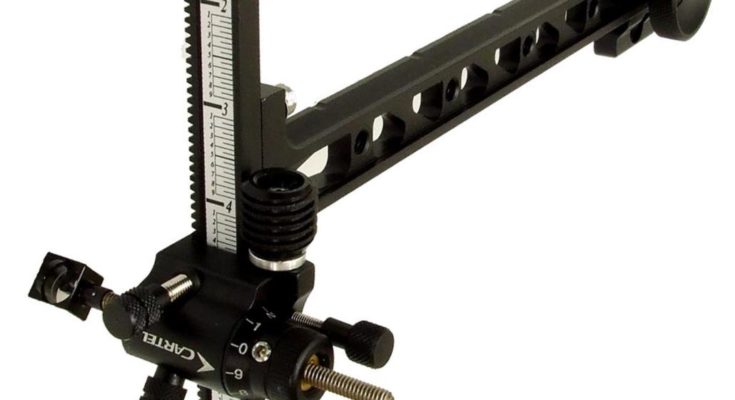What’s the fastest and easiest way to set sight marks for your bow?
Say you got a new bow for Christmas, or a new sight, or your coach just increased your poundage. You’ve noticed, or they told you, that your sight marks are going to be completely wrong. But you have a shoot in the weekend that you want to do well in, or there is a tournament soon. So how do you quickly set up your sight marks?
First, let’s take a look at your sight.
There are different parts at play here. The extension bar, the sight block (the bit that goes up and down) and the sight pin (which can be adjusted left and right).
The extension bar. This usually needs to be as far away from your eye as possible, yet give you enough space to move the sight block up and down with the most range of movement. Most people put this on the full extension, or a few notches in, as that seems to give the best range of movement. If you are on a weak poundage, the further distance you shoot, the more you can bring that extension in towards you, or even invert the sight so it sits even closer to your eye. This provides more clearance from the arrow to your sight, but adjusting the sight has a more magnified effect on the target. Each sight has a different number of holes, but generally speaking, hole zero is closest to the target, and hole 10 is closest to you (or notches. It depends on the bow).
The sight block. When doing sight marks for the first time, move the sight block near the top of the sight block bar. You’ll notice the bar has measurements on it in centimetres. Decide where you’re going to measure your sights from. Some sights have a little pin or triangle pointing to which centimetre you’re looking at. Others, like the basic Cartel sight, just have a plastic block that sits over the top of the measurements, and you can choose to measure your sights from the top of the plastic or the bottom – but once you’ve chosen, make sure you stay with that measurement.
The sight pin. This will be different for each archer, but try to start with it so that the circle you aim with is relatively in line with the nock on the string.
Now your sight is on your bow, take your equipment to a target. If you can, do this outside on a day where there is not much wind. If it is windy, try to find an indoor area where you can get maximum 18 or 20m. Put a target face on the target – I’d recommend an 80cm but a 122cm is fine. Pick a short distance, like 10 or 15m. Make sure that target face is dead in the centre of the target.
Now, shoot two arrows. If your arrows are going high, move your sight up. If they’re low, move it down. Shoot another two. Move your sight again. Shoot another two, and move it again. You can also check here if you need to move your pin left or right – remembering to follow those arrows.
Collect your arrows, and this time shoot 6 arrows without stopping. When you’ve finished the end, check the whole group of the arrows on the target. Draw an imaginary circle around them. Is the centre of the group in the gold? If yes, great!
If they’re not, adjust your sight a little bit, and then shoot another 6. Do this until you can get the centre of that group in the gold. Remember it’s the centre of the group that’s important, not that one arrow in the blue. Only do this a maximum of five ends. Otherwise if you’re searching for perfection, you’ll be there all day!
Now, look at your sight and write down in a book or your phone: a) what extension your bar is at, and b) what centimetre mark your sight is on.
E.g. I would write my 10m mark down as:
10m 4th hole 2.6
That means at 10 metres, the extension sits on number 4, and my sight block is pointing to 2cm and 6mm.
Now move your target (or yourself) back 5 metres so that you’re now at 20m. Move your sight down about a centimetre to start with, but don’t touch the extension bar.
Shoot two arrows, adjust, shoot another two, adjust, then shoot another two. Collect your arrows. Shoot six arrows in a row, then draw that circle around that group. At 20m, your lefts and rights should be able to be tweaked. If you’re lucky, and it isn’t very windy, then that’s your ‘windage’ is correct and you should be able to now leave it where it is no matter how far you go back. If your windage does move as you change distances, make sure the bow isn’t canting to the left or right. If that doesn’t help, then you may need to tune your bow or get your sigh leveled.
Continue for another two ends until that circle centres around the gold, and then write down your sight mark. Again, it might look like this:
20m 4th hole 3.8
When I’m doing sight marks for a target tournament, once I have done 10 and 20m, I then go to my WA 1440 distances (for me that is 30m, 50m, 60m and 70m). For you it might be 25m, 30, 35, 40, or 25, 35, 45, 55. If you have the time, and want to get a lot of sight marks, I’d recommend once you’ve finished 20m, keep going every 5 metres until you have reached the furthest you can go.
Tip:
Keep an eye on your arrow clearance. As you drop your sight block further down the measurements, your sight pin gets closer and closer to your arrows. If it is too far down, and you shoot an arrow, your arrow can hit that sight pin and rip a fletch off, or go ricocheting wildly into a strange part of the target. Remember to get more distance, you can leave the sight block where it is safe and arrows don’t touch it, and simply move the extension bar closer in towards your face. So your 45m sight mark might look like this:
45m 2nd hole 8.4
If possible, try to minimise playing with the windage. If you can do this on a day without much more than a gentle breeze, then that’s the best way to get your sight marks. Then you can find the true centre of where your sight pin should be, instead of winding it left and right all the time depending on the wind.
There you go! When you’ve finished your day, or your morning, you can now go into a competition or junior shoot or club shoot, look up your book, and feel pretty confident that you can set your sight to the right measurement, and then adjust.
If you don’t have time to get sight marks every 5m, try every 10m, and then you can estimate the increments in between.
Remember, sight marks are not rules. They’re more like… guidelines. So if you find when you’re shooting, that they’re a little high on one day, then you can adjust. As long as you have that mark in your book that says where you should start.
Caro Geelen
Originally in issue 527 March/April 2015




